For greater than a dozen years, Lauren Bon has been creating an art work so huge, it has required transferring many tons of earth. But when the primary part of her venture wraps up this week, it is going to be largely invisible. In truth, the clearest proof of “Bending the River,” because the piece is known as, can be a small grate within the concrete mattress of the Los Angeles River in downtown. She and her crew at Metabolic Studio, the not-for-profit artwork and analysis hub she based and directs, have dubbed it “the nice grate.”
Transferring the earth for “Bending the River” wasn’t practically as troublesome as transferring usually intractable bureaucracies — greater than two dozen of them — together with federal, state and municipal businesses such because the U.S. Military Corps of Engineers, the California State Water Sources Management Board and the Los Angeles Division of Water and Energy. That’s as a result of Bon’s venture isn’t any easy artwork set up. As a substitute, as soon as full, it is going to do one thing unprecedented: draw water from the Los Angeles River and channel it to a effectively on a property owned by Metabolic Studio on the western banks of the river. From there, it is going to be filtered, cleaned and delivered to Los Angeles State Historic Park, throughout the road, for irrigation.
Within the course of of constructing it occur, Bon has change into the one particular person to acquire a authorized allow to divert water from the river in additional than a century. That let mandates “useful use” — on this case, irrigating the park. (In different phrases, she will be able to’t flip round and water her garden with it.)
The venture marks a departure from L.A.’s extra typical strategy to its beleaguered river, which has typically consisted of grandiose feats of engineering and much more grandiose grasp plans. “Bending the River” is as a substitute extra akin to acupuncture — a jab that can loosen a tiny piece of the waterway from its concrete straitjacket in order that it’d do what nature meant: Water the land.
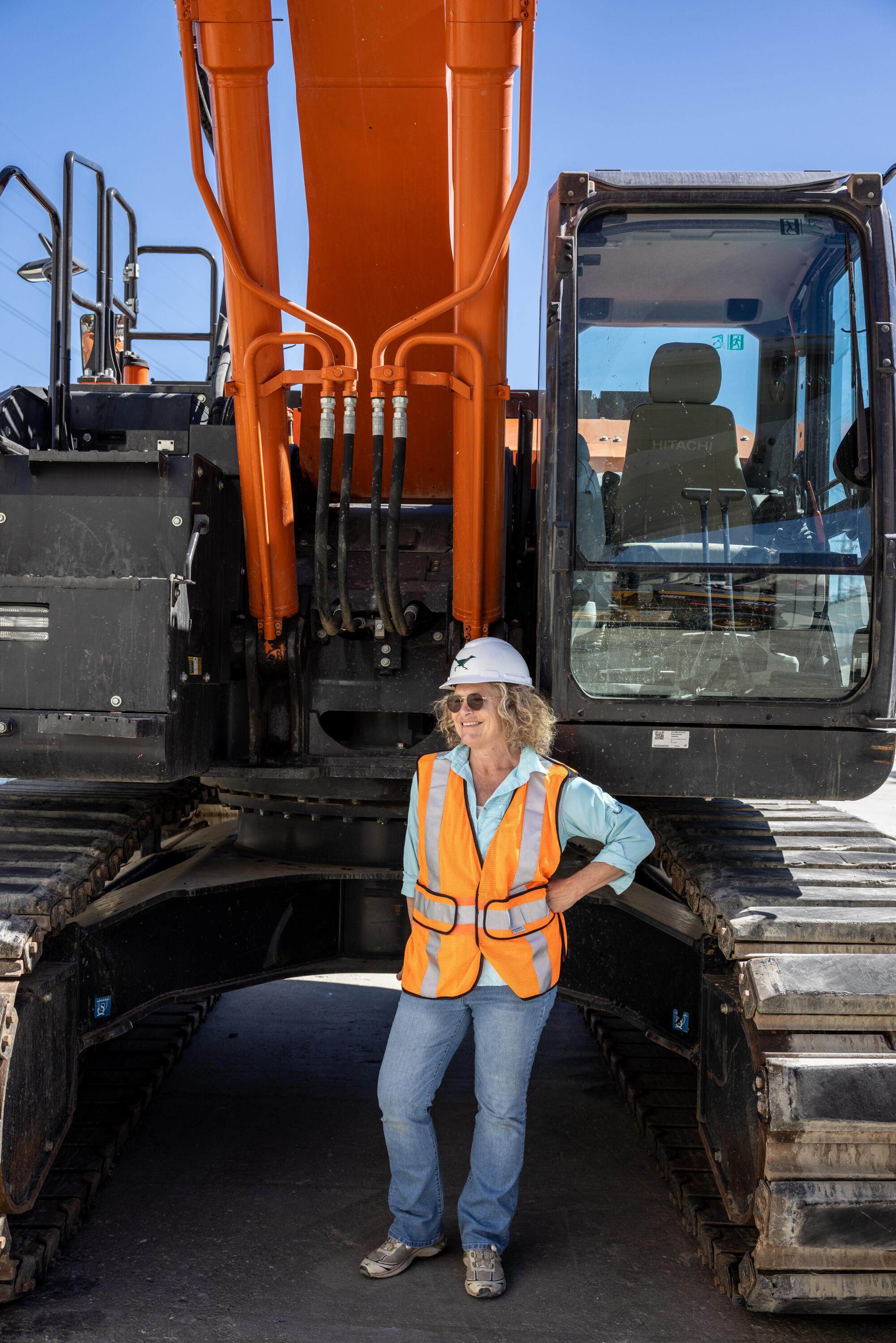
Bon, standing on the concrete mattress of the L.A. River, has been at work on “Bending the River” for a dozen years.
(Jay L. Clendenin / Los Angeles Instances)
“It’s not an enormous quantity of water, nevertheless it’s significant,” says Martin Adams, common supervisor and chief engineer at DWP. The venture won’t solely offset the necessity to import water to irrigate the park, it is going to clear and recycle polluted water that will in any other case be flushed out to sea. “In the event you have a look at all the storm water seize tasks, the larger ones, they’re all up within the San Fernando Valley, so something that goes into the river beneath them has no hope of getting captured.”
Bon says she is working to restore a long-festering harm each geological and psychic. “When now we have no connection to the story of water and this place the place we dwell,” she asks, “how will we join the place to water?”
On monitor to be accomplished by mid-October is a 300-foot stretch of clay pipe that can join the low-flow channel on the middle of the riverbed to the effectively on Metabolic Studio’s Spring Road property. The effectively has been excavated however will stay in a uncooked state; the ultimate design round its cap is to be decided.
Towards the 51-mile size of the river, “Bending the River” is a small enterprise. For an artist, nevertheless, whose work has straddled set up, efficiency and pictures, it’s main. Development on the primary part has value within the neighborhood of $9 million. Metabolic is a part of the Annenberg Basis, of which Bon is a vp and director — that means she is aware of a number of issues about navigating L.A. bureacracy. (Her mom is philanthropist Wallis Annenberg.) The inspiration funds different tasks on the intersection of infrastructure and ecology, together with a wildlife crossing over the 101 freeway in Agoura Hills, presently underneath building.
For now, all of the labor and cash poured into “Bending the River” stays largely out of sight. “We constructed infrastructure,” says Bon, seated amid fashions and renderings in her studio. “It’s very actual, however it is going to actually be underneath concrete.”
As for the nice grate, it is going to be a run-of-the-mill industrial drainage fixture: The Military Corps of Engineers, which operates and maintains the river’s concrete jacket, won’t permit a novel design that would change into an “enticing nuisance.” (That spectacularly named authorized idea describes one thing of nice attraction that would generate security dangers.)
“As an object maker, the truth that the grate is it,” Bon says, “that’s humbling.”
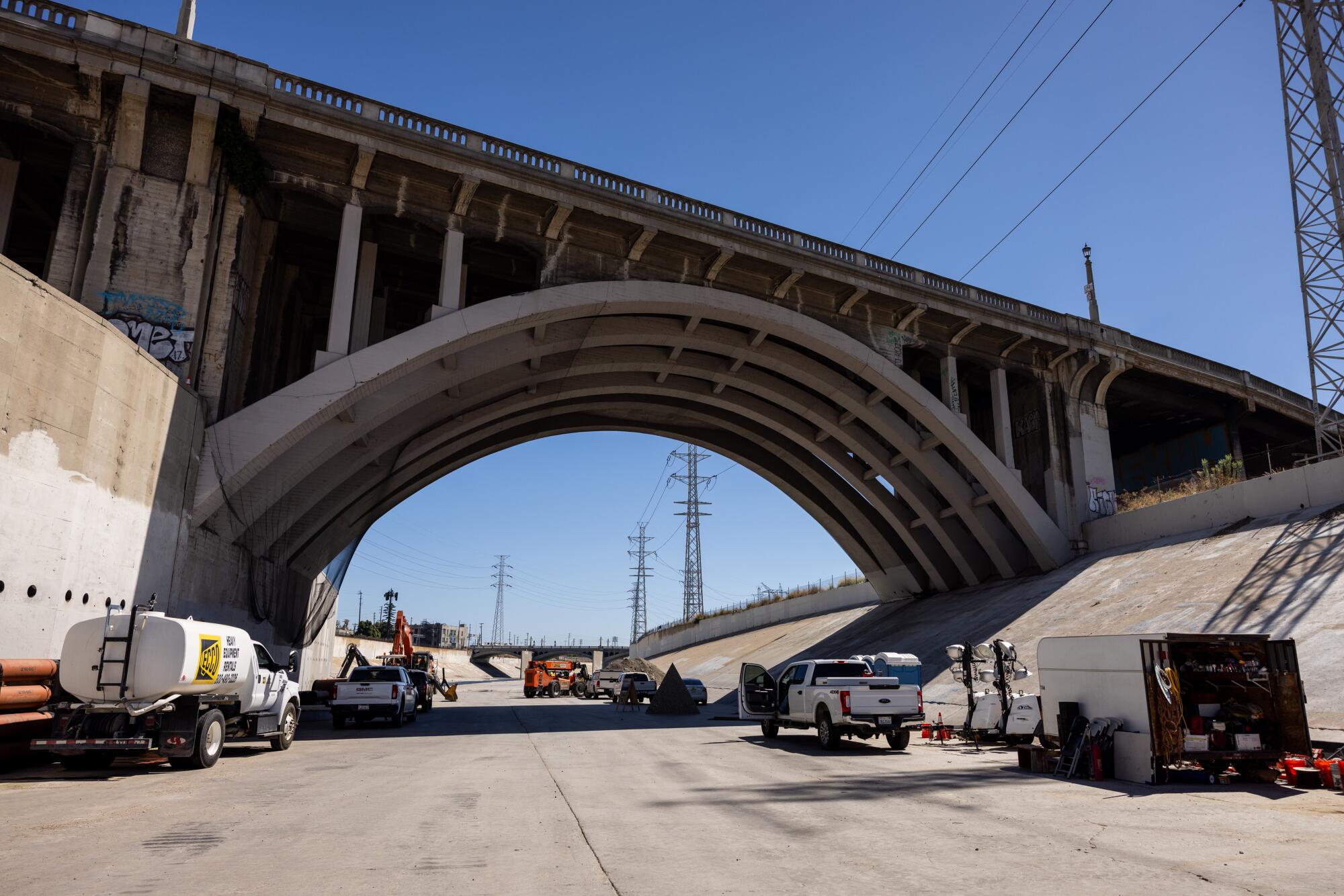
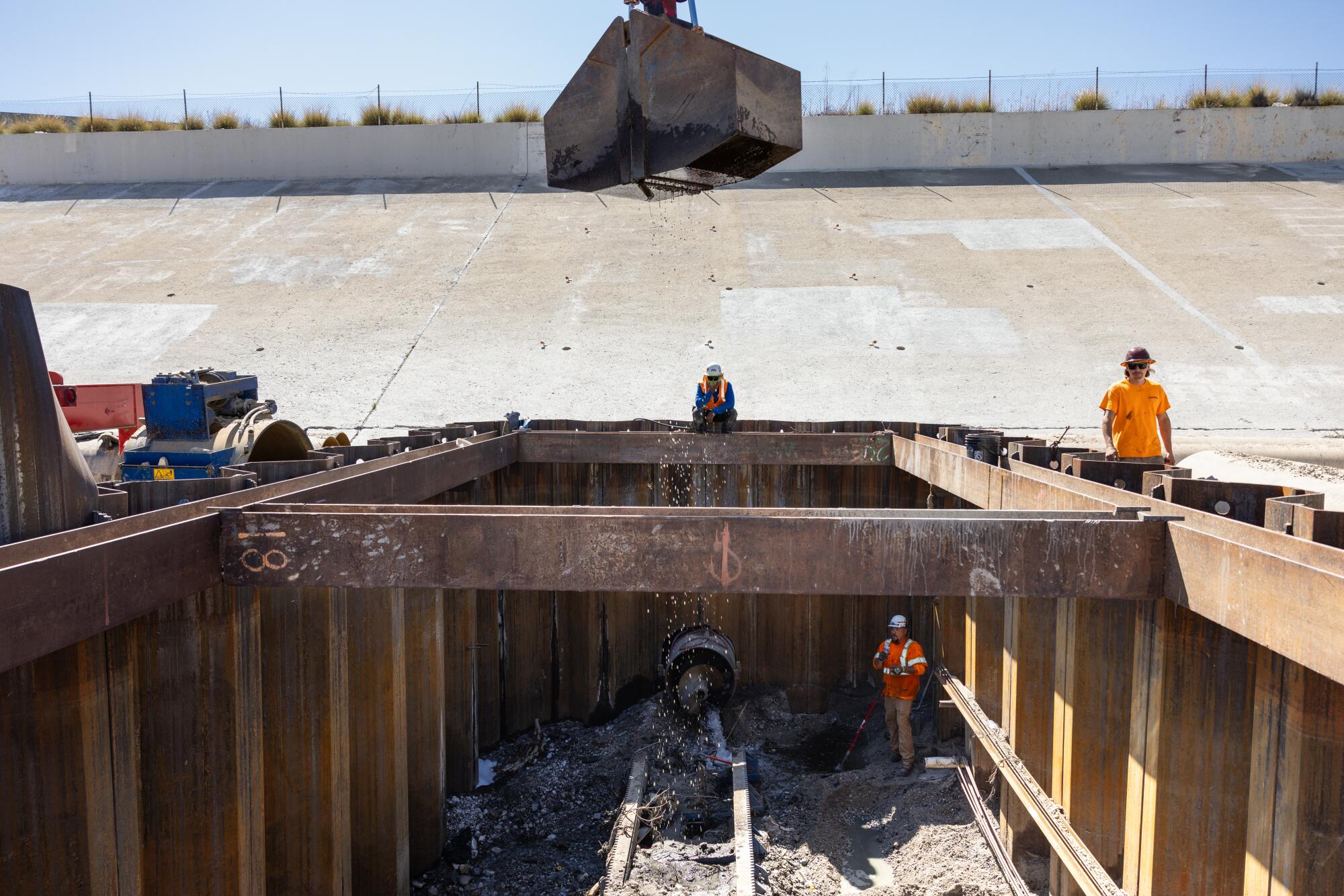
A bridge, at prime, frames the L.A. River’s concrete channel. Backside: Development employees from Geosyntec Consultants excavate the riverbed.
(Jay L. Clendenin / Los Angeles Instances)
Late in August, as downtown temperatures simmered within the excessive 80s, Bon took me and Instances photographer Jay L. Clendenin into the L.A. River to take a look at building. (Members of Metabolic Studio have been main common excursions of the location, which can run by means of Oct. 12.)
Golf ball air pollution, it seems, is a really actual environmental downside. So is each different kind of air pollution: the L.A. River at this part of its life is a soup of handled wastewater, floor runoff and rubbish. “Our water is to water like Velveeta is to cheese,” says Bon. “We’re taking water from the Glendale therapy plant with the E. coli of the Arroyo Seco and mixing that with the water from Dodger Stadium.”
How precisely they are going to clear that water is one thing the crew is simply starting to work on. On the day we go to, employees in Tyvek fits are inside one among Metabolic’s warehouse areas, layering vegetation and different natural matter which may leech pollution out of the water. Sheathed in plastic and penetrated by skylights, the house has a distinctly “X-Recordsdata” vibe.
Naturally, since that is an artwork venture, there’s an aesthetic element.
The concrete slabs that had been minimize out of the river’s mattress with the intention to lay the pipe have been trimmed into triangles and organized in architectonic stacks in a single room of the studio. In a separate, cavernous house, giant mounds of earth displaced by the digging materialize like a large earthwork. Milli Macen-Moore, a researcher on the Metabolic crew, factors out a small California bush sunflower, a local plant, sprouting from one of many piles — an indication of life from soil that has been buried underneath concrete for the reason that river was paved in 1938.
“The concept now we have a seedbed underneath the 51 miles of the concrete of the L.A. River,” says Bon, “is a strong imaginary for ecological regeneration.”
Already, seeds unearthed by the digging have been collected and unfold at one other property on the jap banks of the river, a spot the Metabolic crew refers to as “Undevelopment One.” Bon acquired the property, as soon as a tow yard, in 2015 and commenced eradicating items of tarmac and seeding the soil with native vegetation irrigated with captured rainwater. On our post-Hilary go to, it’s a riot of life, with bumblebees buzzing round blooming amaranth and apricot mallow.
Levi Walden of Geosyntec Consultants, who’s serving as building supervisor for “Bending the River,” says he has labored on numerous underground utility tasks through the years. However “nothing,” he says, “fairly like this.”
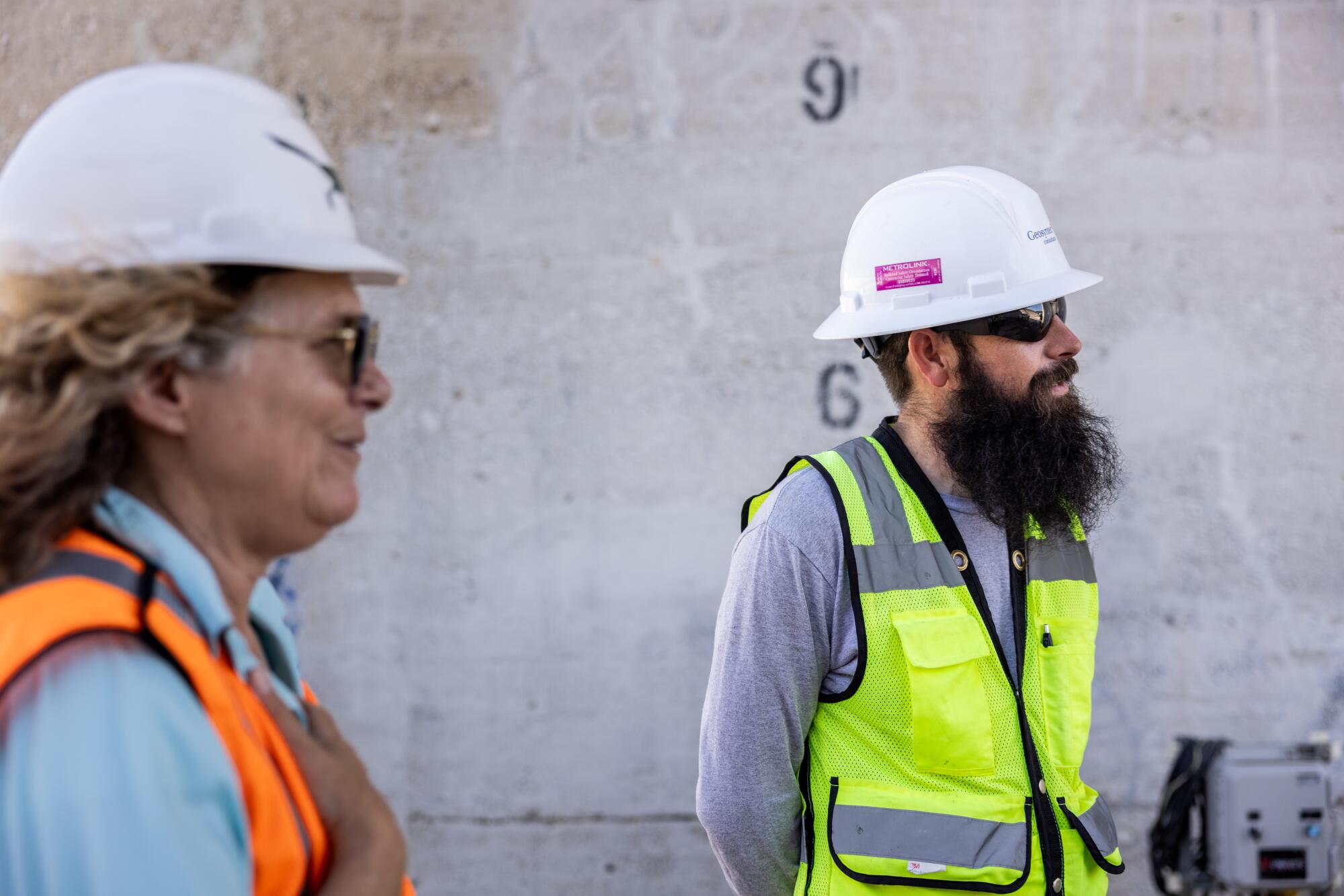
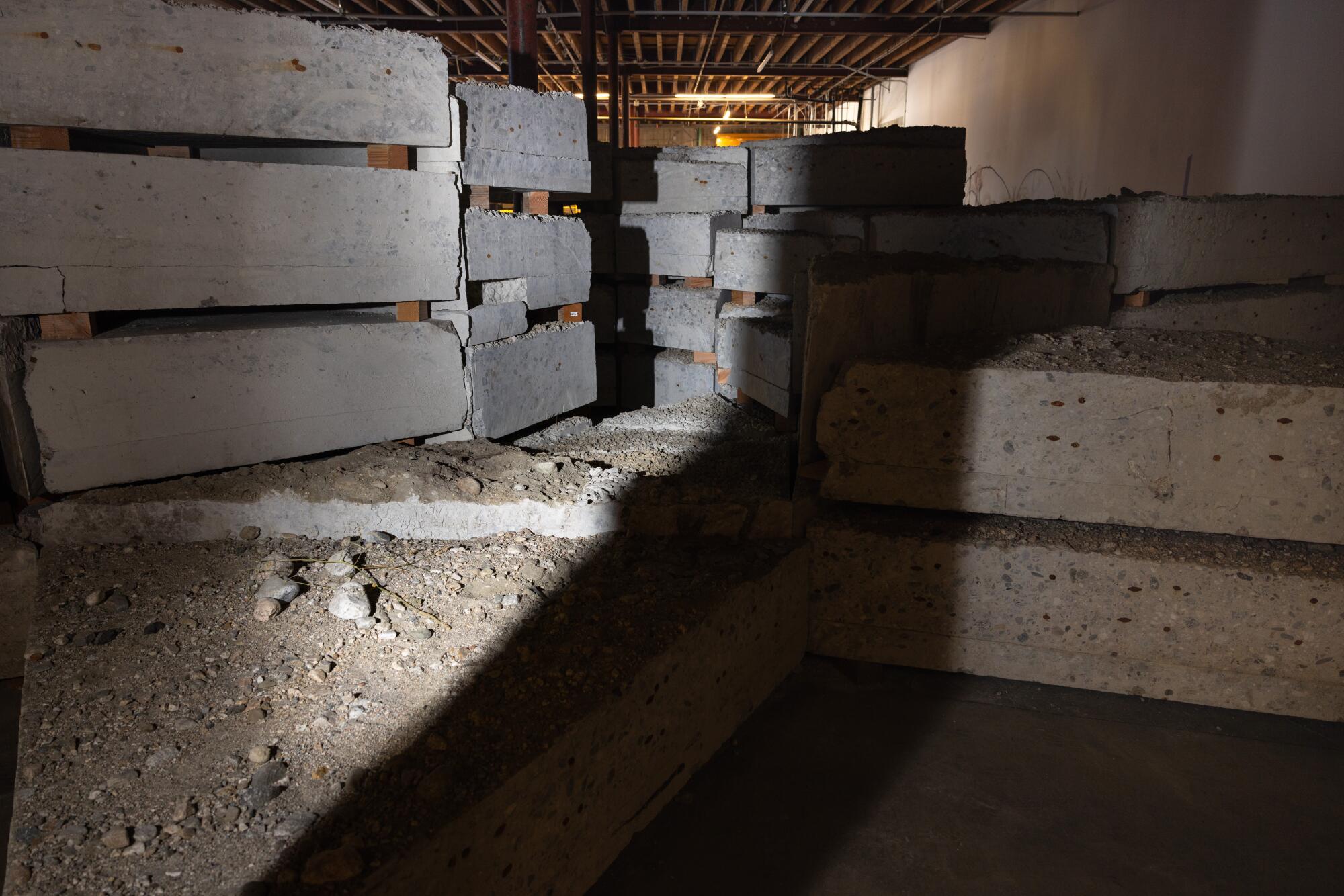
Lauren Bon, at prime, with Levi Walden of Geosyntec Consultants. Backside: Triangular slabs faraway from the riverbed are stacked inside Metabolic’s warehouse house.
(Jay L. Clendenin / Los Angeles Instances)
Bon just isn’t the primary artist to interact the river (or its tributaries) as topic or web site.
Over a century, L.A.’s arroyos have drawn graffitists and their chroniclers — hobo, cholo and in any other case. Within the Nineteen Seventies, Judy Baca introduced collectively a crew of painters to create “The Nice Wall of Los Angeles,” a half-mile-long collection of murals within the Tujunga Flood Management Channel. Extra lately, artist Debra Scacco, whose cartographic items discover the L.A. River and its panorama, organized a bunch present at Monitor 16 gallery impressed by riverine themes. Late this month, a bunch of artists and cultural leaders, together with members of the Tongva and Chumash communities, will stage a competition titled “Procession” that can embrace a stroll tracing the river’s historic programs.
The multidisciplinary arts group Clockshop additionally has vital connections to the river: Its workplaces lie on the western banks, in Frogtown, and for years it has staged cultural programming on the Bowtie Parcel, an 18-acre strip of commercial land on the jap banks that’s now being transformed right into a state park (thanks partly to Clockshop’s advocacy). Late final month, the group launched a three-year multimedia venture, “Take Me to Your River,” consisting of oral histories, public storytelling occasions and a video documentary.
Whereas town has lengthy turned its again on the river, says Clockshop government director Sue Bell Yank, for generations of individuals it has functioned as unofficial public house and improvised yard. “Kids who grew up within the neighborhood would entry it and have sturdy emotions about it,” she says. “It’s this useful resource.”
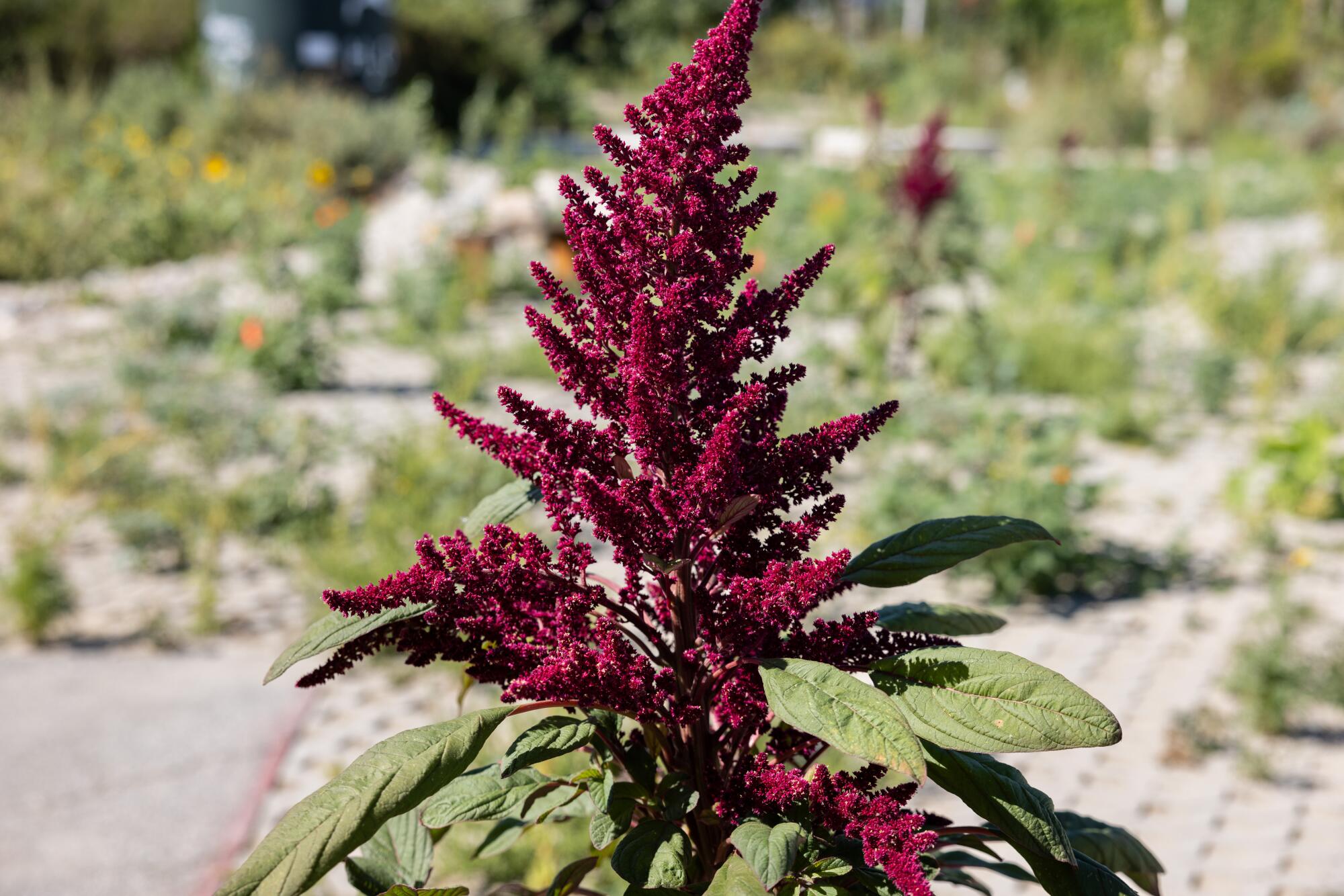

Amaranth grows at Undevelopment One, prime, a former tow yard on the jap banks of the L.A. River that Metabolic Studio has slowly rewilded. Backside: Metabolic’s Milli Macen-Moore walks by means of the backyard.
(Jay L. Clendenin / Los Angeles Instances)
For Bon, ecology has all the time been a essential issue.
In 2005, the artist planted a cornfield — a piece she coyly titled “Not a Cornfield” — within the deserted railyard that now harbors Los Angeles State Historic Park. The piece helped remediate a polluted web site and supplied the surreal imaginative and prescient of downtown rising from behind tidy furrows of corn. (It recalled the sector of wheat planted by artist Agnes Denes on landfill in Decrease Manhattan in 1982.)
Eight years later, Bon staged “100 Mules Strolling the Los Angeles Aqueduct,” during which she and members of the Metabolic crew, together with a crew of wranglers from the McGee Creek Pack Station, traced all the 240-mile size of the aqueduct from the Owens Valley to L.A.
For all her work with the soil, Bon says she doesn’t place herself within the custom of land artists, rearranging earth right into a spiral like Robert Smithson or making a desert megasculpture à la Michael Heizer. “I’ve a lot respect for a few of these artists’ journeys,” she says. “However I really feel my trajectory has been to make reparation relatively than make monuments.”
She sees herself extra as interventionist and choreographer.
The artist, 61, studied dance as an undergraduate at Princeton College and as soon as apprenticed with Martha Graham (“very intense, very personal and deeply collaborative”). As a graduate pupil on the Massachusetts Institute of Expertise (she has a grasp’s diploma in structure), Bon was influenced by Fluxus artists resembling Nam June Paik and Charlotte Moorman, who had been jabbing on the boundaries between topic areas on the faculty’s Heart for Superior Visible Research, famend for its mixture of scientists and inventive avant-garde. “There was a way of an expanded area,” says Bon, “that I believe ‘Bending the River’ is part of.
“At a choreographic stage,” she explains, “it’s about excited about the water as a personality in a protracted historical past of place that desires to be repositioned.”

Lauren Bon amid the sprouting blooms at “Undevelopment One.”
(Jay L. Clendenin / Los Angeles Instances)
It was “Not a Cornfield” that led on to “Bending the River.” Because the corn was not meant to be consumed, Bon had assumed she would merely irrigate her venture with runoff from the L.A. River — till she was knowledgeable it was towards the legislation to attract its water and not using a allow. That have bought her excited about the river’s relationship to the land round it.
“The L.A. River and the state park, they appear like they ought to be linked,” says Bon. “They’re actually proper subsequent to one another.” However a century of engineering has damaged that connection. By “bending” the river again into town, Bon hopes to hyperlink them as soon as once more.
For a time, her idea included a water wheel that will draw the water as much as the extent of the park. However she in the end scrapped that concept over issues about upkeep and the introduction of an object that took away the main target from what actually mattered: water and land.
“Bending the River” is a piece of environmental engineering. It’s also a murals — and by presenting it as such, Bon has made hidebound authorities businesses maybe extra amenable to experimentation than they may have been in any other case. “I can intervene in bureaucracies as an outsider,” she says. “I’m not a problem-maker internally, I’m a problem-maker externally. And the issue isn’t seen as an issue if it’s seen as a short-term speculative inquiry.”
An artist like Bon, says Deborah Weintraub, chief deputy engineer on the Bureau of Engineering, can convey a contemporary angle to water insurance policies that audiences may not in any other case be contemplating. Her work, she says, “is making the invisible seen.”
A part of what stays invisible — along with the 300 toes of clay pipe put in by Metabolic Studio — is the unique riverbed.
When the crews from Geosyntec started to take away slabs of the concrete, what was revealed beneath was a circulate of contemporary water and the seed-bearing soil that had sat untouched since 1938. Regardless of our greatest efforts to bury her, nature continues her circulate.
“It’s extraordinary,” says Bon. “Life is that sturdy and that highly effective. It’s so hopeful.”
#Lauren #Bons #Bending #River #rewilding #L.A.s #waterway
